Microsoft Surface Pro 3 Review
by Anand Lal Shimpi on June 23, 2014 3:55 AM ESTBattery Life
Microsoft made no sacrifice in battery capacity in pursuit of Surface Pro 3's thin chassis design. The new tablet features an integrated 42Wh battery just like the previous two models. Charging duties are handled by an external 31W charger with a brand new magnetic connector. Microsoft never seemed to get a good MagSafe clone working in the previous models, so Surface Pro 3 abandons the previous design entirely in favor of something a bit more sensible.
The new connector no longer looks like an oversized MagSafe connector, and instead features a thin plastic insert that mates with the charge port on Surface Pro 3. Charge time hasn't changed, you can fully charge the device in around 2.62 hours:
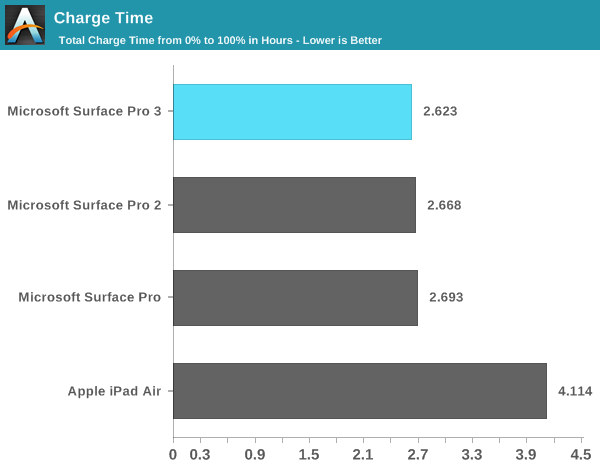
The device-side connector features 40 pins but you only need 12 of them to charge the device. The remaining pins are used for Gigabit Ethernet, USB, DisplayPort (up to 4096 x 2304) and audio. Microsoft seems hell bent on avoiding Thunderbolt at all costs so instead of embracing the standard it has created a custom alternative of its own doing. The benefit to Microsoft's connector is it can obviously deliver more power than Thunderbolt can, the downside is that it can't send PCIe and thus you don't get support for any ultra high bandwidth external storage devices. I still would rather see Microsoft implement Thunderbolt as there's at least an existing ecosystem built around that but here we are three generations into Surface and if we haven't seen it by now I don't think we're ever going to.
The supplied power adapter includes a USB charge port capable of delivering 1A at 5V.
As Surface Pro 3 is designed to be both a laptop and a tablet I've run it through both our Windows laptop battery life tests and our tablet battery life tests.
Laptop Battery Life
As a laptop, Surface Pro 3 delivers comparable battery life to other optimized Haswell ULT designs. I threw in Sony's Vaio Pro 13 into the mix because it has a similar sized battery (37Wh vs. 42Wh) and is one of the most power efficient Windows Ultrabook platforms on the market. Surface Pro 3 manages to deliver similar battery life, which means it's a little less power efficient but the two are within the same range at least.
Compared to Surface Pro 1 and 2, Surface Pro 3 at worst delivers similar battery life and at best increases range on a single charge by up to 20%. We're looking at 3.75 hours - 7.6 hours of notebook usage on a single charge depending on usage.
It's worth noting that there's a substantial advantage in battery life if we look at the 13-inch MacBook Air running OS X. I only mention this because of Microsoft's insistence on comparing Surface Pro 3 to Apple's popular line of notebooks.
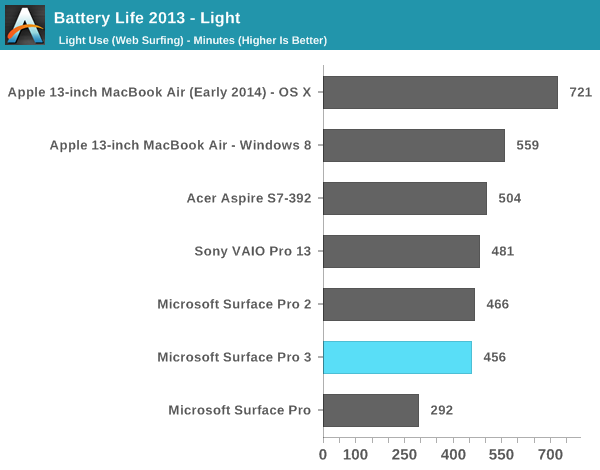

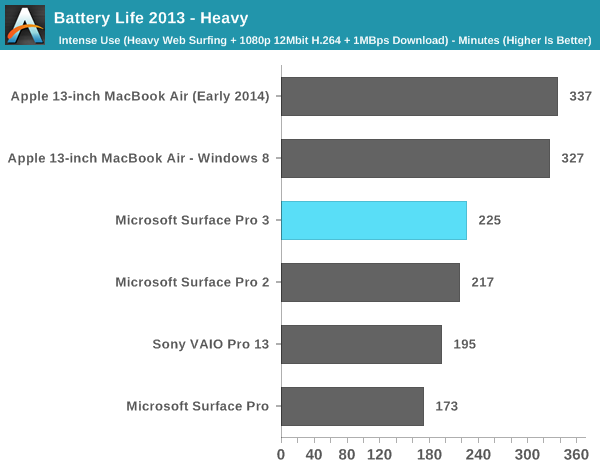
Tablet Battery Life
Tablet workloads are going to be far more display power bound than anything else. Here we see 7.58 - 8.03 hours of continuous usage, a slight regression compared to Surface Pro 2. Video playback remains more power hungry than web browsing, which is something I've noted in previous tablet-evaluations of Intel's Core silicon. I don't believe Intel's Core processors are very optimized for video decode power consumption. If anything is going to change with the move to Broadwell and Core M I suspect video decode power may be it.
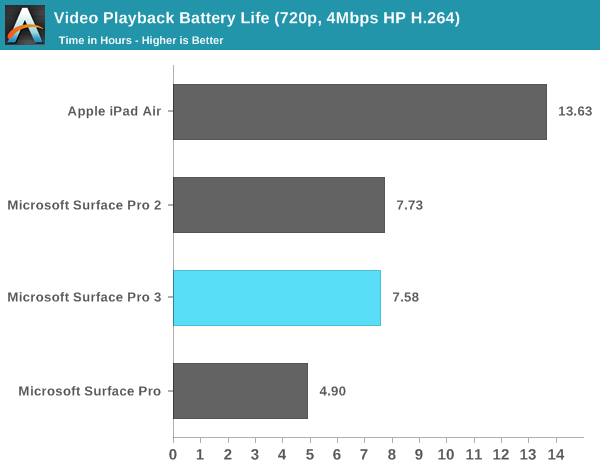
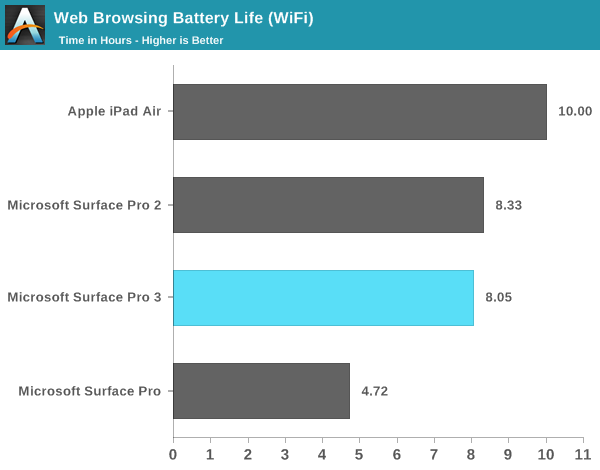


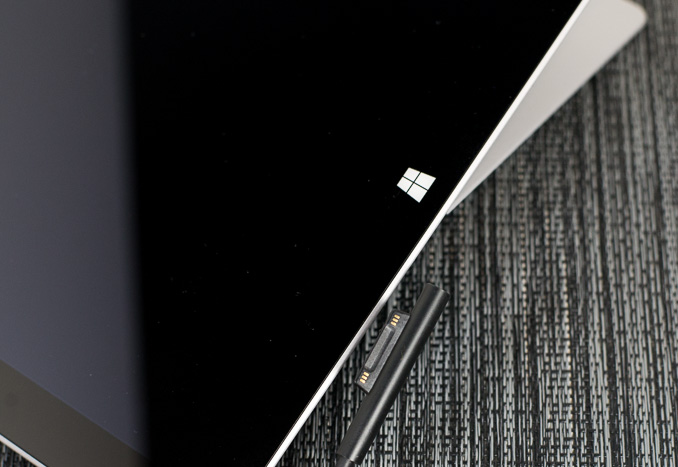
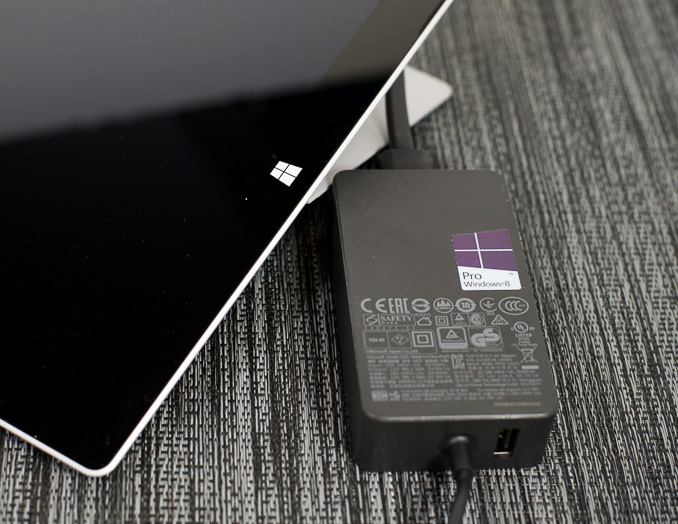








274 Comments
View All Comments
ymcpa - Monday, June 23, 2014 - link
Tegra is ARM and that means you will be using windows RT and won't be able to run desktop apps. You can get a Surface or Surface 2 which cost a lot less than the Pro 3.lmcd - Tuesday, June 24, 2014 - link
A K1 would be a lot less compromises...ymcpa - Tuesday, June 24, 2014 - link
A K1 is an ARM processor. Therefore, no x86 apps. The device would just be a pure tablet. How is that less compromises?lmcd - Sunday, June 29, 2014 - link
Less compromises than the other options he suggested, duh. K1 vs T4 is rather silly to even wonder about.edwpang - Monday, June 23, 2014 - link
What about disk space usage? Does it use WIMBoot?chizow - Monday, June 23, 2014 - link
This is the first Pro I've considered buying. Hope they validate them at work so I don't have to go out-of-pocket, but I'll pick one up either way. Definitely agree the Type Cover should come standard though! Especially since they'll probably release a battery cover shortly after.nerd1 - Monday, June 23, 2014 - link
Wait, we have waited ONE DAMN MONTH and get only 8 page review? For one of the most anticipated devices for year? Is anandtech short on manpower?I always enjoyed anandtech review over anything, but now I'd rather surf user forums for through analysis...
XabanakFanatik - Monday, June 23, 2014 - link
I feel the same way. It looks like they didn't actually listen to any of the comments they requested for review ideas. Where are the comprehensive benchmarks? Why did they only benchmark Dota 2? Why did they not provide a thorough thermal profiling of the device showing average and maximum temperatures under tested loads? Why couldn't they include a simple crystaldiskmark run of the ssd?I mean, I can run Intel XTU with prime95 and get a graph that gives me a solid thermal profiling in about 5 minutes, showing temperature to clock speed to TDP or thermal throttling.
You've disappointed me, Anand.
mkozakewich - Monday, June 30, 2014 - link
And they only compared battery life and power to the iPad and Macbooks, for most of it, rather than other competitors like the Yoga Pro.Actually, I don't think they've even mentioned other convertible PCs, they're just trying to prove it's a valid ultrabook first.
jeffkibuule - Monday, June 23, 2014 - link
Battery life tests take a LONG time, during which you cannot use the device.